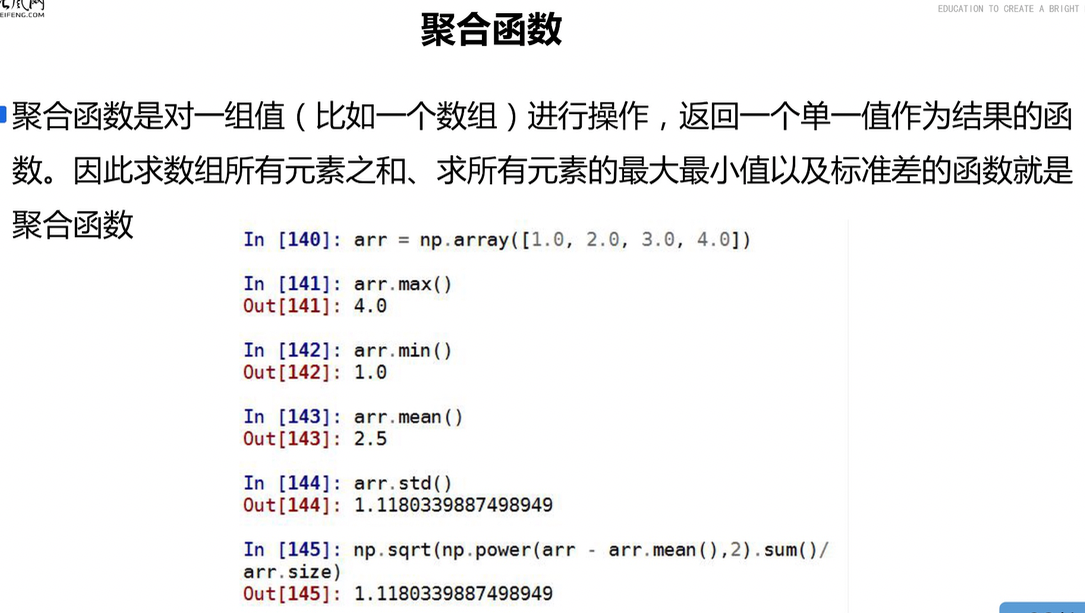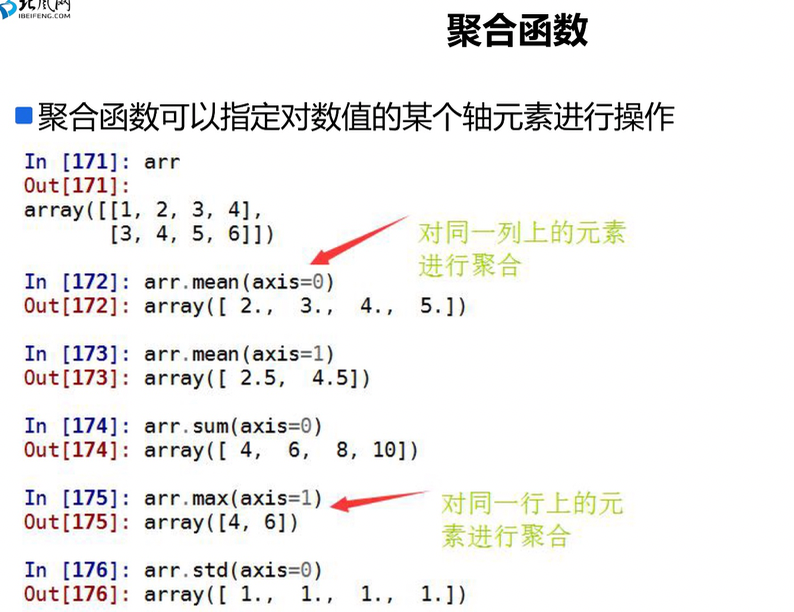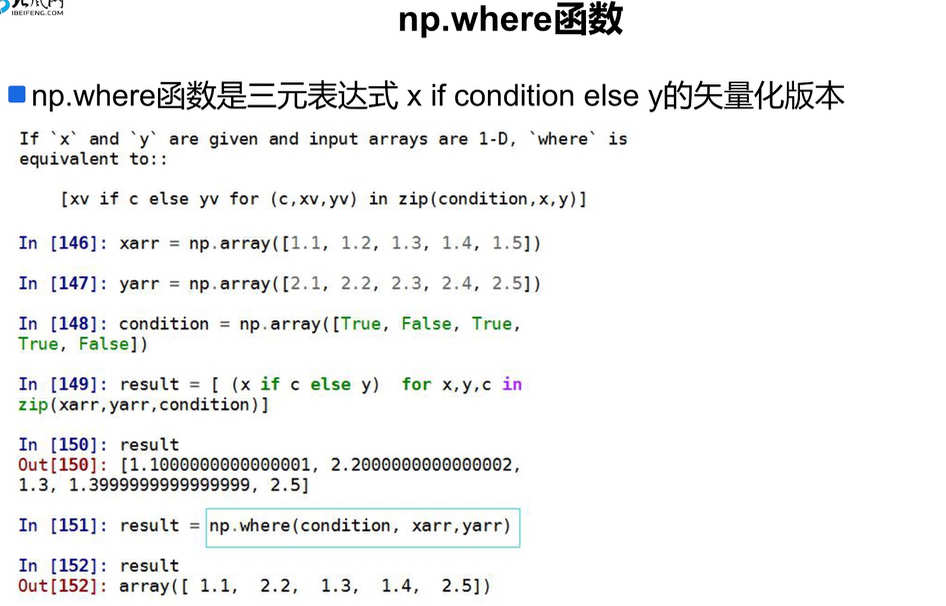-
numpy
import numpy as np
为什么numpy运算比纯Python要块

属性
ndarray.shape

a = numpy.arange(12)
array([ 0, 1, 2, 3, 4, 5, 6, 7, 8, 9, 10, 11])
a.shape=(2,6)
[[ 0 1 2 3 4 5]
[ 6 7 8 9 10 11]]
a.shape=(3,2,2)
array([[[ 0, 1],
[ 2, 3]],
[[ 4, 5],
[ 6, 7]],
[[ 8, 9],
[10, 11]]])
ndarray.ndim
数组维数,一维是1,二维是2...
ndarray.size
数组中的元素 数量,总的数据量 二维矩阵5行8列数量为40
ndarray.itemsize
一个数组元素的 空间大小(字节)
ndarray.dtype
ndarray的类型
np.bool
用一个字节存储的布尔类型(True或False)
'b'
np.int8
一个字节大小,-128 至 127
'i'
np.int16
整数,-32768 至 32767
'i2'
np.int32
整数,-2 31 至 2 32 -1
'i4'
np.int64
整数,-2 63 至 2 63 - 1
'i8'
np.uint8
无符号整数,0 至 255
'u'
np.uint16
无符号整数,0 至 65535
'u2'
np.uint32
无符号整数,0 至 2 ** 32 - 1
'u4'
np.uint64
无符号整数,0 至 2 ** 64 - 1
'u8'
np.float16
半精度浮点数:16位,正负号1位,指数5位,精度10位
'f2'
np.float32
单精度浮点数:32位,正负号1位,指数8位,精度23位
'f4'
np.float64
双精度浮点数:64位,正负号1位,指数11位,精度52位
'f8'
np.complex64
复数,分别用两个32位浮点数表示实部和虚部
'c8'
np.complex128
复数,分别用两个64位浮点数表示实部和虚部
'c16'
np.object_
python对象
'O'
np.string_
字符串
'S'
np.unicode_
unicode类型
'U'
创建数组的时候指定类型
a = np.array([[1, 2, 3],[4, 5, 6]], dtype=np.float32)
a.dtype
dtype('float32')
arr = np.array(['python', 'tensorflow', 'scikit-learn', 'numpy'], dtype = np.string_)
arr
array([b'python', b'tensorflow', b'scikit-learn', b'numpy'], dtype='|S12')
若不指定,整数默认int64,小数默认float64
字符串 np.string_
创建


a = numpy.arange(15)
b = a.reshape(3,5)
[[ 0 1 2 3 4]
[ 5 6 7 8 9]
[10 11 12 13 14]]
a.reshape((3,-1))
[[ 0 1 2 3 4]
[ 5 6 7 8 9]
[10 11 12 13 14]]
a.reshape((5,-1))
[[ 0 1 2]
[ 3 4 5]
[ 6 7 8]
[ 9 10 11]
[12 13 14]]
c = a.reshape((3,-1))
e = c.T
c
[[ 0 1 2 3 4]
[ 5 6 7 8 9]
[10 11 12 13 14]]
e
[[ 0 5 10]
[ 1 6 11]
[ 2 7 12]
[ 3 8 13]
[ 4 9 14]]
生成随机数组

数组的索引、切片

形状修改

类型修改

创建配置文件
jupyter notebook --generate-config
vi ~/.jupyter/jupyter_notebook_config.py
取消注释,多增加
## (bytes/sec) Maximum rate at which messages can be sent on iopub before they
# are limited.
c.NotebookApp.iopub_data_rate_limit = 10000000
数组去重

ndarray运算

a = numpy.array([1,2,3,4])
print(a==4)
>>
[False False False True]
numpy会用矩阵对象的每一个数据和值作比较,返回布尔值
b = numpy.array([[1,2,3,4],[2,3,4,5]])
print(b == 5)
>>
[[False False False False]
[False False False True]]
b = numpy.array([[1,2,3,4],[2,3,4,5]])
c = (b==5)
print(b[c])
>>[5]

a = numpy.array([1,2,3,0])
print(a.min()) .>>> 0
print(a.max()) >>> 3
数组间运算


a = numpy.array([[1,5],[5,0]])
b = numpy.array([[2,8],[1,10]])
二维矩阵运算
a
[[1 5]
[5 0]]
b
[[ 2 8]
[ 1 10]] 2
numpy.dot(a,b)
a.dot(b)
规则:
第一行乘第一列相加得到矩阵第一位
第一行乘第二列相加得到矩阵第二位
第二行乘第一列相加得到矩阵第三位
第二行乘第二列相加得到矩阵第四位
1*2 +5*1 =7
1*8 + 5*10 = 58
5*2 +0*1 =10
5*8 +0*10 = 40
[[ 7 58]
[10 40]]

a = numpy.array([1,2,3,4])
print(a,a.dtype)
>>>>
[1 2 3 4] int32
a = numpy.array([1,2,3,4.0])
print(a,a.dtype)
>>>
[1. 2. 3. 4.] float64
a = numpy.array([1,2,3,'4'])
print(a,a.dtype)
>>>
['1' '2' '3' '4'] <U11
a = numpy.array([1,2,3,4])
a
>>
[1 2 3 4]
b = numpy.array([[1,2,3,4],[2,3,4,5]])
b
>>
[[1 2 3 4]
[2 3 4 5]]
c = numpy.array([[[1,2,3,4],[2,3,4,5],[5,6,7,8]]])
c
>>
[[[1 2 3 4]
[2 3 4 5]
[5 6 7 8]]]

a = numpy.array([1,2,3,4])
print(a[1:3])
>>
[2 3]
a = numpy.array([[ 1 3 4 6 7]
[ 2 4 2 5 76]
[41 13 42 63 71]])
print(a[0:2])
>>
[[ 1 3 4 6 7]
[ 2 4 2 5 76]]
print(a[0:2,2]) 可取列值
>>
[4 2]
b = a[:,0:2] 所有行第0列和第1列的数据
[[ 1 3]
[ 2 4]
[41 13]]

按照行
c = numpy.array(
[[
[10,20,30,40],
[20,30,40,50],
[50,60,70,80]
]])
1
print(c.sum(axis=1))
>>
[100 140 260]
三维
c = numpy.array(
[[
[10,20,30,40],
[20,30,40,50],
[50,60,70,80]
]])
2
print(c.sum(axis=2))
>>
[[100 140 260]]
按照列
c = numpy.array(
[[
[10,20,30,40],
[20,30,40,50],
[50,60,70,80]
]])
1
print(c.sum(axis=1))
>>
[100 140 260]
三维
c = numpy.array(
[[
[10,20,30,40],
[20,30,40,50],
[50,60,70,80]
]])
2
print(c.sum(axis=2))
>>
[[100 140 260]]

a = numpy.arange(15)
print(a)
[ 0 1 2 3 4 5 6 7 8 9 10 11 12 13 14]
a = numpy.arange(2,30,2)
[ 2 4 6 8 10 12 14 16 18 20 22 24 26 28]
不包括30
numpy.linspace(0,100,11)
[ 0. 10. 20. 30. 40. 50. 60. 70. 80. 90. 100.]
初始化
a = numpy.zeros((4,))
print(a)
[0. 0. 0. 0.]
a = numpy.zeros((4,6))
print(a)
[[0. 0. 0. 0. 0. 0.]
[0. 0. 0. 0. 0. 0.]
[0. 0. 0. 0. 0. 0.]
[0. 0. 0. 0. 0. 0.]]
numpy.ones((元组))
a = numpy.ones((2,3,4))
print(a)
[[[1. 1. 1. 1.]
[1. 1. 1. 1.]
[1. 1. 1. 1.]]
[[1. 1. 1. 1.]
[1. 1. 1. 1.]
[1. 1. 1. 1.]]]
三维 3行 4列
随机
numpy.random.random((2,3))
生成2行3列的矩阵 介于0-1之间
[
[0.07261529 0.37003586 0.00799021]
[0.24945076 0.92461768 0.80258728]
]


e的次幂计算
a = numpy.arange(3)
numpy.exp(a))
分别得出
e的0次
e的1次
e的2次
e=2.7182
[1. 2.71828183 7.3890561 ]
求开方
a = numpy.sqrt(81)
a
9.0
type(a)
<class 'numpy.float64'>
a.dtype
float64
a = numpy.arange(3)
numpy.sqrt(a)
[0. 1. 1.41421356]
以矩阵传入参数,得出每个数据的开方

numpy.floor(矩阵)
a = numpy.array([1.3,2.4,5.6,6.1,6.9])
[1.3 2.4 5.6 6.1 6.9]
b = numpy.floor(a)
[1. 2. 5. 6. 6.]
横向拼接
a = numpy.floor(10*numpy.random.random((2,3)))
b = numpy.floor(10*numpy.random.random((2,3)))
a
[[9. 1. 6.]
[1. 3. 8.]]
b
[[7. 7. 0.]
[1. 9. 8.]]
numpy.hstack((a,b))
[[9. 1. 6. 7. 7. 0.]
[1. 3. 8. 1. 9. 8.]]
纵向拼接
[[1. 0. 6.]
[0. 8. 8.]]
[[4. 8. 2.]
[9. 7. 4.]]
vstack
[[1. 0. 6.]
[0. 8. 8.]
[4. 8. 2.]
[9. 7. 4.]]
纵向切分
[[3. 4. 4. 2. 9. 3.]
[7. 9. 1. 1. 8. 7.]
[8. 8. 6. 2. 2. 7.]
[5. 5. 8. 7. 8. 1.]]
numpy.vsplit(a,2)
[
array([[3., 4., 4., 2., 9., 3.],
[7., 9., 1., 1., 8., 7.]]),
array([[8., 8., 6., 2., 2., 7.],
[5., 5., 8., 7., 8., 1.]])
]
numpy.hsplit(a,(3,4))
a=
numpy.floor(10 * numpy.random.random((2, 12)))
[[3. 8. 3. 5. 1. 9. 7. 5. 9. 1. 1. 0.]
[0. 4. 3. 9. 9. 0. 0. 2. 8. 1. 0. 7.]]
numpy.hsplit(a,(3,5))
[
array([[3., 8., 3.],
[0., 4., 3.]]),
array([[5., 1.],
[9., 9.]]),
array([[9., 7., 5., 9., 1., 1., 0.],
[0., 0., 2., 8., 1., 0., 7.]])
]
在3-5构成第二个array
view 浅复制
a = numpy.arange(12)
b = a.view()
b is a
false id 不一样
b.shape=2,6
改变b的结构
[[ 0 1 2 3 1234 5]
[ 6 7 8 9 10 11]]
a
[ 0 1 2 3 4 5 6 7 8 9 10 11]
b[0,4] =1234 改变b中一个值
b
[[ 0 1 2 3 1234 5]
[ 6 7 8 9 10 11]]
a
[ 0 1 2 3 1234 5 6 7 8 9 10 11]
copy 深复制
a = numpy.arange(12)
b = a.copy()
[ 0 1 2 3 4 5 6 7 8 9 10 11]
[ 0 1 2 3 4 5 6 7 8 9 10 11]
b.shape=3,4
[[ 0 1 2 3]
[ 4 5 6 7]
[ 8 9 10 11]]
b[0,1] = 32
[[ 0 32 2 3]
[ 4 5 6 7]
[ 8 9 10 11]]
a
[ 0 1 2 3 4 5 6 7 8 9 10 11]
a.argmax(axis=0)
a = numpy.array([[1,3,61,5],[4,2,55,6]])
[[ 1 3 61 5]
[ 4 2 55 6]]
index = a.argmax(axis=0)
[1 0 0 1]
按照列,
第一列 索引1 的4大
第二列 索引0 的3大
。。。。。
得出 1001
按照索引取出相应值
max = a[index,range(a.shape[1])]
[ 4 3 61 6]
a.argmax(axis=1)
index1 = a.argmax(axis=1)
[2 2]

a = numpy.array([[1,3,61,5],[4,2,55,6]])
[[ 1 3 61 5]
[ 4 2 55 6]]
b = numpy.sort(a)
[[ 1 3 5 61]
[ 2 4 6 55]]
二次学习




